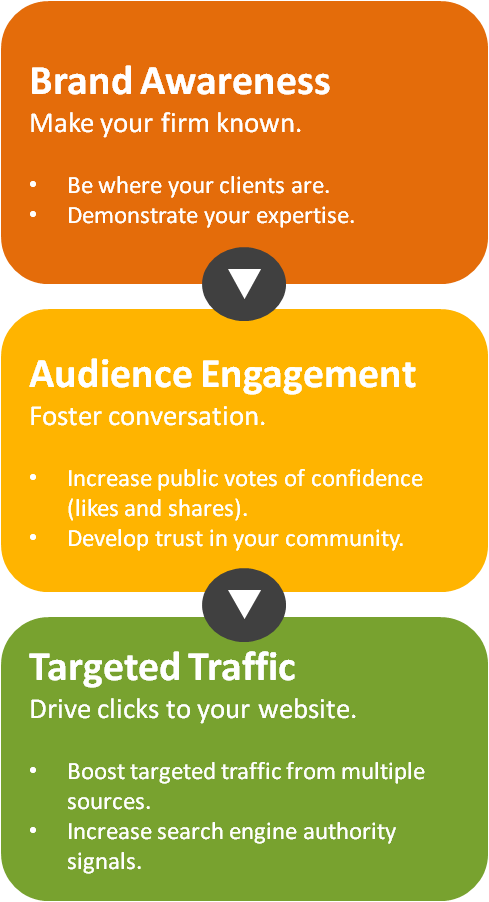Answers to Questions From Blog Services Clients
About Blog Services Features
What are the primary features of the Blogging Platform?
FindLaw’s blogging platform offers an exclusive dashboard to enable effective blogging. Primary features include:
- Integrated RSS feed featuring national and local news libraries to assist with idea generation
- FindLaw Blog Optimizer which will assist you in creating a search engine friendly post
- Quick Linking feature to allow for easy and effective deeplinking to your website
- Training Module that provides access to a robust set of blogging and technical training material.
What is the Optimizer and how does it work?
Once a blog article is written, you have the option to click on the Optimizer feature on the lower left-hand side of the platform. This feature will then look at each individual post and will return a list (based on predefined parameters) of items you may want to consider in order to optimize the post.
Additionally, within the Optimizer pop-up is a static link called “tips for every post,” which also contains information you should consider while making the posts. You will then have the option to revisit the blog post and make these changes to create a more effective blog post.
It is important to understand that the Optimizer is designed to provide support for FindLaw clients who are unfamiliar with basic search engine optimization principles. It is not intended to dictate your choices or limit your creativity. It is also not used internally, as the FindLaw blog writers employ a more complex and organic optimization strategy that evolves over time in response to the news cycle, topical and search trends, and the differing needs of new and established blogs. Your best guide in optimizing posts for visibility is to write about topics your community of clients, potential clients and word-of-mouth referrers will find interesting and to use language that is understandable and relatable.
Can I write a blog post for a Practice Area that I am not signed up for?
We encourage you to write articles that are focused on your practice area. By writing articles that are not related to your selected practice area, it may not generate the visibility or traffic that the blog could potentially receive.
How many times a week should I blog?
Our Best Practices indicate that an ideal blog website should have one to two postings per week; however, we encourage you to blog as much as you feel comfortable.
I currently have a Blog Service Starter subscription – can I buy FindLaw delivered content?
FindLaw does not currently have a blog content-only offering. However, content services are provided with Blog Service Essential and Premium. Contact your Sales Consultant or Account Manger to discuss the benefits of upgrading.
What services do I get in year two of my subscription?
If you are a Blog Service Essential or Premium customer, FindLaw will continue to post timely blogs on your firm’s behalf. You will also continue to benefit from our ongoing search engine optimization (SEO) program, including directory submissions, social media bookmarking and promotion on the FindLaw Blog Network. If you have a site redesign in year two, the blog is also eligible for a redesign to keep the “likeness” of the main site.
What is the blog network?
The blog network is a directory of blogs hosted on blogs.findlaw.com. This network is organized by practice area and includes all Blog Service Essential, Blog Service Premium and FirmSite Premium blogs. The inclusion to this network will lend FindLaw.com’s authority to the blog, resulting in increased performance and faster ongoing indexing.
About Effective Blog Content
How many words should each post be?
250 to 400, ideally. Much shorter, and you may lose search visibility. Longer and readers may lose interest. Feel free to break longer posts into a series.
How many characters long should the post title be?
65, counting spaces.
What should the title contain? Geography and keyword(s)?
Remember, your title is your hook. The purpose of the title is to capture the reader’s attention. Post titles can also impact search engine visibility. Ideally the title would contain both the primary keyword (often the category name) or a related term AND a target geographical term (city, county, state). However, in many cases, the title may only contain the keyword or key phrase. Use your best judgment.
How many times should the keywords be used within a post?
The chosen keyword (either the main keyword or a related term) should ideally appear once in the title, once in the first paragraph or body of the post, and once in the extended content.
When writing a post, I see two tabs: “body” and “extended.” Do I need to place content in both?
Yes. For all but the shortest posts, it is recommended that you “break” the post into the body (which will appear on the main blog page) and extended content (which will appear on that post’s unique page). Think of the body as an introduction designed to capture the reader’s interest. The extended content should go into more detail.
What’s the best way to break the post into the “body” and “extended” portions?
A good rule of thumb is “two paragraphs, then break.” In practice, however, it is important to consider the flow of the post. Ideally, you will break at a place that will encourage the reader to continue on to the extended content. The main things to avoid are making it appear the post is finished and breaking the post in such a way as to confuse the reader.
What types of formatting (underlining, italics, long paragraphs, bulleted lists, etc.) are good and bad on the web?
- Bulleted or numbered lists are great. They help the reader skim and scan, and they improve overall readability.
- Italics and bolding are often problematic. They can make a post seem junky. Use of bold and italics should be limited or avoided altogether.
- Long paragraphs and complex sentence structure negatively impact readability. Both should be avoided.
- Never underline text. Readers expect underlined text to be a link.
How should the three to five categories I’ve chosen be balanced in terms of the amount of content in each?
Each category should ideally represent about 33 percent (for three categories) to 20 percent (for five categories) of the content on the blog. You may choose to prioritize one topic over others, but a balanced approach is generally better.
How many categories should I select for each post?
Posts should ideally appear in only one category. While the scope of a post may include other categories, it should be focused more on one than another.
Should I create a new category every time I want to write about a new topic?
No. In some cases, you may want to add a category that is more appropriate for a discrete topic you intend to cover repeatedly and in depth. In most cases, however, it is best to place posts into an existing category. Long lists of categories can cause reader confusion, particularly if those categories only have one or two posts in them.
How much variance from the exact SEO category keywords is positive/negative? (Does it make a difference if you switch from singular to plural? How about “car accidents” vs. “auto accidents” or “car crash?” How about “pit bull attack” vs. “dog bites?”)
As a general rule, you should be guided by the Optimizer and use the identified term exactly. This does not mean, however, that using a singular (or plural) version or a related term is bad or will keep your blog from performing. Use your best judgment and focus on using the type of language that makes the most sense to your readers in the given context. Remember, the Optimizer offers basic, general guidance. It is not intended to limit your ability to discuss topics in a natural and engaging fashion that accurately reflects your style and personality.
Are some sources better than others?
Of course. While the factors impacting the value of a source may be complex and variable, a good rule of thumb to apply is “only use sources you would trust if you were the reader of this blog.”
Are there any sources I should not use?
Use your best judgment, but we recommend you avoid using other attorneys’ blogs or other attorneys’ websites as source material.
How many sources should be cited for one post?
One. Specifically, there should only be one link per post to any site other than the client’s FirmSite. There will probably be instances in which citing two or more sources is the best thing to do; however, it is best to limit the number of source material links to one per post.
Do I have to cite a source?
If you use a news item or other material available online as a reference, it is a blogging best practice (and a matter of journalistic ethics) to cite that source and provide the reader with a link to that source. If, on the other hand, you are writing a post from your own experience, it is not necessary to cite any source.
Should I include a link to my website within the post?
If you have a page on your website that covers the topic of the post, it is a good idea to include a link to that page within the post. You may want to include language like: “To learn more about this topic, please visit the car accident [link to Car Accident page] page on our website.”
I’ve heard there are certain days, or hours during the day, when it is better publish posts on my blog. Should I publish a post right away when it is complete, or should I schedule it for a certain time?
Our advice is to publish posts when they are finished. There are some indications that certain times and days of the week are slightly more favorable than others, but these variations are relatively small and most clients find it easier to just publish upon completion. See below for an exception to this rule.
Is it okay to publish two posts in the same day, or should I spread those posts out?
There is nothing wrong with publishing two posts on the same day. If, however, you know that those posts will be the only ones you publish that week, it is better to space them out over a period of several days. You may want to schedule those posts for publication later. (For instructions on scheduling posts for later publication, see the Movable Type training documentation.)
Who should I notify if I run into a problem or see something wrong with my blog?
Your account manager can help you with any technical difficulties or questions you may have.
How much analysis or opinion is allowed/expected/good in a post?
In FindLaw-authored posts, we don’t provide analysis or opinion beyond what is generally considered to be “legal common knowledge.” We do routinely “spin” information toward the perspective of our clients. Both legal common knowledge analysis and spin are generally good and expected. If you wish to include detailed legal analysis or an opinion that may be controversial, we encourage you to think first about whether these will be useful to your readers. If so, then go ahead.
Should I use quotes from the source article in my posts?
Use quotes sparingly, and only quote words a person actually spoke. In general, it is not good to quote written material, and you should certainly never quote large blocks of written material. Rewrite, rephrase, spin, paraphrase – just don’t cut and paste. In order to perform, your content must be unique.
What do tags do, and what is the best way to use them?
Tags have no SEO value, but some of the same principles apply. Think of tags as a way to help organize the posts on a blog. Imagine your blog as it will be in several years – full to the brim with lots of posts on tons of different topics. Tags make it easy for the user to find the information they want on a blog with hundreds and hundreds of posts. Tags could be thought of as sub-categories or topical notations.
How should I handle the use of subjects’ names in posts?
Limit the use of names to public figures whenever possible. It is generally a bad idea to use the name of a person accused of a crime or the victim of an accident – particularly if it is a salacious crime or a fatal accident (or if the victim is a child). This is true even if the news source you are drawing from mentioned the subject by name.
Who should I notify if I run into a problem or see something wrong with my blog?
Your account manager can help you with any technical difficulties or questions you may have.





